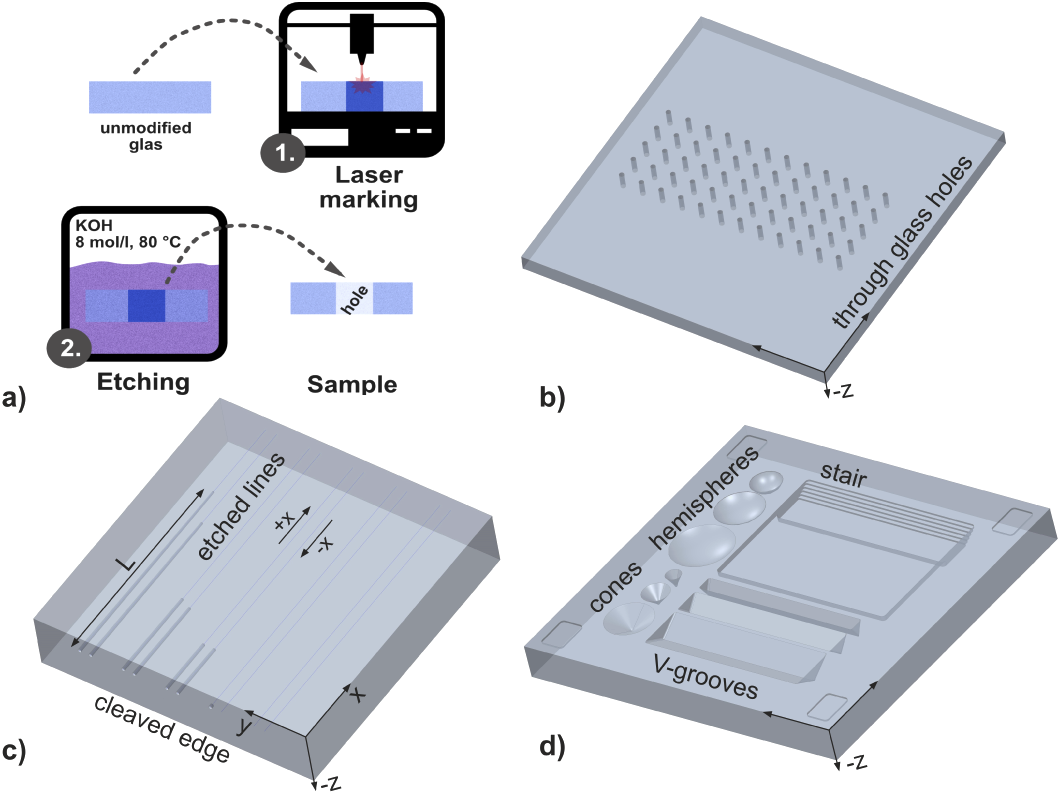Abstract: We present a method for the selective etching of borosilicate glass (SCHOTT Borofloat 33), in which we modify the glass with an ultrashort pulse laser and subsequent wet chemical etching. The BF33 glass is often used in microtechnology to produce sensors, actors, and fluidic chips as it can be bonded to silicon wafers by anodic bonding. The glass is irradiated and modified by circular polarized laser light with a wavelength of 1030 nm. By etching the glass with potassium hydroxide, the modified material can be removed. In this study, the selectivity was analyzed dependent on the laser parameters pulse repetition rate, pulse duration, writing speeds, and pulse energy. A selectivity up to 540 could be observed in this study. Finally, the manufacturing capabilities for three-dimensional free form shapes in BF33 are demonstrated and compared with fused silica.
Selective laser-assisted chemical etching (SLE) is a bulk micromachining technology for transparent materials. The technology uses a strongly focused laser spot for writing structures into the volume of a glass substrate. These structures are subsequently removed from the substrate. Compared to classical lithography based glass etching processes, this concept has the advantage that three-dimensional shapes can be fabricated [1]. As a result of the light matter interaction, nano-gratings and/or nano-porosities result in the material [2]. The modified volume can be removed by subsequent wet chemical etching.
Matsuo et al. have shown that it is possible to apply the selective laser etching with potassium hydroxide (KOH) on borosilicate glasses like PYREX . They reported selectivities up to 500 by using a microscope objective with a magnification of 100x and a numerical aperture (NA) of 1.35. The current study investigates the selective laser etching of SCHOTT BF33. The glass morphology is modified with a focused femtosecond laser source and subsequently etched with KOH. We could show that it is possible to achieve a high etching selectivity by using an objective with a magnification of 20x and a NA of 0.4 in combination with high writing velocities. In addition, we demonstrated the three-dimensional shaping capabilities of the BF33 etching process compared to the reference material Fused Silica.
The manufacturing process for laser-induced selective chemical etching (SLE) is based on two main production steps. In a first step, the glass morphology is modified by the applied ultrashort laser pulse (Section 2.1, Fig. 1(a)) and in a second step the glass substrate is shaped by wet chemical etching (Section 2.2). For the SLE process, different laser writing parameters have a great influence on the result of the subsequent etching process, regarding etching rates, selectivity, surface roughness, etc. The influence of different laser parameters can therefore only be assessed indirectly based on the etching results. A first scan of the parameter field was done by characterizing through holes in glass (Section 2.3, Fig. 1(b)). The selectivity of the etching process was investigated by measuring the etching rate of the modified and unmodified material for the selected parameter field (Section 2.4, Fig. 1(c)). The potential of BF33 for the manufacturing of three-dimensional shaped components was demonstrated on different test geometries and compared with respective reference structures in Fused Silica (Section 2.5, Fig. 1(d)).

Fig1
The glass modification is induced by focusing a femtosecond laser into the substrate and moving the focus inside the material along predefined paths. The modification process inside the glass depends on various laser parameters like pulse repetition rate, pulse duration and pulse energy. In our laser configuration the pulse duration can be tuned from 300 fs to 10 ps. In addition, the pulse repetition rate can be adjusted from a single pulse to a repetition rate of 10 MHz. The linearly polarized laser delivers a beam with a wavelength of 1030 nm which is circular polarized by a quarter waveplate. A microscope objective with a NA of 0.4, a magnification of 20x and a cover glass correction of 1.1 mm is used to focus the laser beam into the substrate.
The controlled movement of the substrate with a 3-axis linear stage system (x, y, z) enables the writing of user defined lines and structures into the substrate. The setup is additionally equipped with a galvanometer scanner which allows the deflection of the laser beam in the field of view of the objective. The galvanometer scanner setup is used for the writing of three-dimensional shapes. If the 3D structures are larger than the field of view, stitching with the 3-axis linear stage is used in addition.
上一篇: 减少化学品使用的清洁优化
下一篇: Pre-Gate氧化清洗顺序的优化